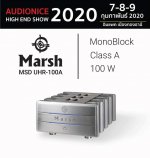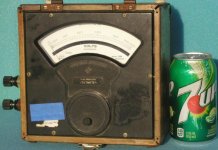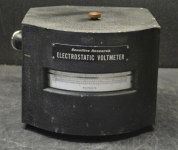Sorry you have to use your imagination. The equations are here constant charge is an unloaded transducer and constant voltage would be with Cload going to infinity.
https://www.bksv.com/media/doc/Bv0048.pdf#page=23
Imagination? What's that?
Thanks, I'll take a read.
John
At home, I listen background.
For real listening, I go to the Jazz loft. Live.
Jn
Oh, also..I see gap values of 2.5mm and film thickness in the 5 micron range, but cannot find any information on centering tolerance of the rotor (or diaphragm, if someone really wants to be picky). I'm trying to work out the maximum imbalance the diaphragm will see with mechanical tolerance issues. While I normally work at roughly 15 micron tolerance in my basement, what do ESL manu's keep w/r to diaphragm centering? With a 5000 micron stator to stator, a 50 micron tolerance means the induced voltage at film can vary 1%. With a kv at stator, 10 volts imbalance at film. With 10e+12 ohms per square, 90% of the diaphragm is 10e+11 ohms from the 10 meg resistor. (Assuming a square diaphragm)
So the difference current front to back will be less than 10e-10 amps. 100 picoamps. If stator is shorted to the film 10 % up across the entire diaphragm, that is 10 nano amps.
So what is typical stator current to compare 100 picoamps against?
It is always a good idea to question white papers, so many statements are taken as truth without facts presented.
Let me pull some numbers from memory (low confidence but a starting point)
ESL 63
Bias voltage 5200V (although I measure closer to 4800 with an electrostatic voltmeter)
Panel C stator to stator 5000 pF
Peak AC (before arc-over) 5KV
So 3.5 KV at 100 Hz (the typical max stress point) into 5nF X 4 panels or 20nF I come up with 43 mA using a lot of incorrect assumptions and shortcuts so I'm probably off. I have a Quad that needs service in my shop I can measure but I would not be getting into it very quickly.
Thank you, that is good enough.Let me pull some numbers from memory (low confidence but a starting point)
ESL 63
Bias voltage 5200V (although I measure closer to 4800 with an electrostatic voltmeter)
Panel C stator to stator 5000 pF
Peak AC (before arc-over) 5KV
So 3.5 KV at 100 Hz (the typical max stress point) into 5nF X 4 panels or 20nF I come up with 43 mA using a lot of incorrect assumptions and shortcuts so I'm probably off. I have a Quad that needs service in my shop I can measure but I would not be getting into it very quickly.
10e-10 / 43e-3. = .25e-7 , or 25e-9 imbalance ratio...25 parts per billion.
And the imbalance was written as a problem?
And that is based on a 50 micron physical imbalance. If we consider only film front to back physical imbalance of 5 microns divided by the film relative permittivity of 3, 25ppm turns into less than 1 ppm.
Best part, our assumptions and back of envelope calcs can be off by 4 orders of magnitude and still it shows ridiculously small numbers.
Who wrote that ESL stuff anyway? Who peer reviews such stuff? My goodness, if I ever refereed a write up like that, I would draw in a new box. Not the "accept with no changes", not "accept with mods", not "reject", but a box that says "reject with prejudice, tar and feather this person, and put the video on you tube".
Sigh, and people accept this stuff without question.
Jn
Ps. When I referee articles for publication, even the really incorrect ones, I will provide guidance for the author, and inform the journal that the authors can indeed receive my name, contact me, and I will help them in their research design so that they can do it right. Typically, the researchers mess up the build part, they normally get the equations right.
Last edited:
Now that you mention electrostatic VM, Richard Lees used one every time he listened. adjusted the variac to have same DC HV for consistent sound.
I had my MLSSA system and mic at listening location so i could see what effect that had had on FR.
What is the relationship with DC HV, sensitivity and HF response?
-Richard
I had my MLSSA system and mic at listening location so i could see what effect that had had on FR.
What is the relationship with DC HV, sensitivity and HF response?
-Richard
Last edited:
And nobody thought to report that perceived dependence of sound with DC voltage???Now that you mention electrostatic VM, Richard Lees used one every time he listened. adjusted the variac to have same DC HV for consistent sound.
I had my MLSSA system and mic at listening location so i could see what effect that had had on FR.
What is the relationship with DC HV, sensitivity and HF response?
-Richard
Btw, what is electrostatic VM?
Your last question.. Isn't that the question you instigated this entire discussion with?
I would castigate and badmouth you for starting this discussion, however... I can't. The discussion is quite fruitful.
Jn
Ps. Had to reach for the word "castigate", hope I used it right..😕
...means electrostatic Volt Meter, of course. 🙂 Electrostatic voltmeter - Wikipedia
Yeah, i have lots of interesting questions. More questions than answers.
THx-Richard Using same chassis as Damir stereo amp:

Yeah, i have lots of interesting questions. More questions than answers.
THx-Richard Using same chassis as Damir stereo amp:

Last edited:
Yah, that's ok, I still hate your guts..😀...means electrostatic Volt Meter, of course. 🙂 Electrostatic voltmeter - Wikipedia
Yeah, i have lots of interesting questions. More questions than answers.
THx-Richard
Been thinking about your tenure at that "lab" place....
With the recent project, we now need people to do the work....sigh
They can't hire when the experience is there to teach, only when there is a project..great.
I must admit....it is really weird sitting in on an interview where I decide not to ask questions so as to not embarrass the interviewee.
I must be getting old...
Jn
I hate you too 😀
There is an old African saying... when a man dies, a whole library burns down.
Our future is in mentoring the next generation... its my new career.
Sometimes asking the right (or wrong) questions develops a lot of new ideas and information and results.
Thats what I look for.
-Richard
There is an old African saying... when a man dies, a whole library burns down.
Our future is in mentoring the next generation... its my new career.
Sometimes asking the right (or wrong) questions develops a lot of new ideas and information and results.
Thats what I look for.
-Richard
Strangely enough, my desires no longer include personal targets. My goals only involve the teaching of the young ones.I hate you too 😀
There is an old African saying... when a man dies, a whole library burns down.
Our future is in mentoring the next generation... its my new career.
Sometimes asking the right (or wrong) questions develops a lot of new ideas and information and results.
Thats what I look for.
-Richard
Questions are key.
Jn
That's your amp at the high end audio show 7-8-9 2020?THx-Richard Using same chassis as Damir stereo amp:
Strangely enough, my desires no longer include personal targets. My goals only involve the teaching of the young ones.
Questions are key.
Jn
 😎
😎... and grumpy 😉
I would argue with you..
But, unfortunately I agree with you😀
Jn
Electrostatic voltmeter. Usually look like the pictures below. They draw zero current at DC and very little at AC. Sensitive instrument (or whats left of it) may still make them but they are all quite vintage.
I spent many weekends at Richards and he never had one. He had a HV probe like the Fluke, which will load the supply and cannot be used at the panels. His speakers had 100 Meg build out resistors at each panel for the HV Bias. One of the last upgrades was a regulated modular HV bias supply. It seemed to make a difference, not that we ever did a blind test or measurement. I never installed them in my Quads.
I spent many weekends at Richards and he never had one. He had a HV probe like the Fluke, which will load the supply and cannot be used at the panels. His speakers had 100 Meg build out resistors at each panel for the HV Bias. One of the last upgrades was a regulated modular HV bias supply. It seemed to make a difference, not that we ever did a blind test or measurement. I never installed them in my Quads.
Attachments
Old and new circuit design was mentioned in earlier posts. So Asking just out of curiosity who designed the LM3886 chip. I know the company but who were the people behind the design ? Arguably it is the most famous class A/B Chip. Though I am newbie would be nice to learn basic explanation of that circuit design uniqueness.
Thanks and regards.
Thanks and regards.
Old and new circuit design was mentioned in earlier posts. So Asking just out of curiosity who designed the LM3886 chip. I know the company but who were the people behind the design ? Arguably it is the most famous class A/B Chip. Though I am newbie would be nice to learn basic explanation of that circuit design uniqueness.
Thanks and regards.
Making Silicon Valley: Innovation and the Growth of High Tech, 1930-1970 - Christophe Lecuyer, Professor of the History of Science and Technology Christophe Lecuyer - Google Books
Widlar was one of the early engineers. see above for more names.
-RNM
I spent many weekends at Richards and he never had one. .
Hmmm must have been an optical illusion on my part. 🙄
Not.
Thx-RNMarsh
...means electrostatic Volt Meter, of course. 🙂 Electrostatic voltmeter - Wikipedia
Yeah, i have lots of interesting questions. More questions than answers.
THx-Richard Using same chassis as Damir stereo amp:
View attachment 816783
Richard, what amp is inside?
THx Damir
I dont know... they never told me they were doing this directly... might be one of your boards in it with more OPS devices? I will look inside Friday or next week. I have no idea what their marketing was thinking -- they dont speak english. And I need that chassis for my bi-amp speakers.
-Richard
-Richard
Last edited:
According to some people, here, and to the conservation law, nothing happens.There is an old African saying... when a man dies, a whole library burns down.
For others, it is a part of the consciousness of the universe which disappears. Does the beauty of this universe make sense?
- Status
- Not open for further replies.
- Home
- Member Areas
- The Lounge
- John Curl's Blowtorch preamplifier part IV

